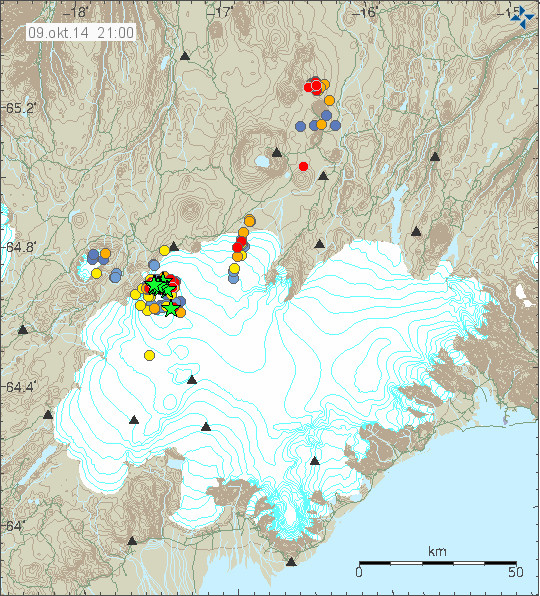This is the daily Bárðarbunga volcano update. If you wonder why I write this every day even if there are no major changes there is a reason to it. There is an eruption taking place and there is always something going on. There are more notes about other things at the end of this article.
Current status in Bárðarbunga volcano on 9-October-2014
- Largest earthquake today had the magnitude of 5,2, it took place at 21:22 UTC. Second largest earthquake today took place at 04:37 UTC and it had the magnitude of 5,0.
- There is increased activity over the dyke origin area in Bárðarbunga volcano. Largest earthquake so far had the magnitude of 4,8 at 19:13 UTC today. I don’t think this is a good sign, since it appears to me that more magma is trying to get into the dyke. The dyke is however not wide enough to take in all this new magma that is trying to pressure its way into it. So it is now trying to expanding it at is starting point. If that expansion of the dyke fails the magma is going to start looking for new way out. What path the magma is going to go is not possible to predict. When the formation of new dyke starts, there is going to be a new earthquake swarm with thousands of earthquakes as happened from 16-August to 29-August when the eruption started.
- Bárðarbunga volcano caldera continues to drop even if the magma pressure is increasing. I don’t know why that is. The caldera is not going to collapse until most or all of the magma leaves the magma chamber holding it up. Until then it is going to stay up. When the magma finds a path out of the magma chamber it is going to start a large eruption that is only going to last 60 – 75 hours (less than a week). Until then it is going to be more of the same. New dykes forming and sometimes erupting.
- Bad weather has prevented me from seeing anything on the web cameras. I have also not heard anything about the lava field current status on the news today.
- Today there was more earthquake activity along the dyke then yesterday. Suggesting increased pressure in it, as would be expected since I am seeing more pressure in the magma system (based on earthquake activity).
- Nothing else to report far as I know.
The ring fault in Bárðarbunga volcano
The ring fault that has formed in Bárðarbunga volcano can clearly be seen on this image today from Icelandic Met Office.

The ring fault in Bárðarbunga volcano. Copyright of this image belongs to Icelandic Met Office.
Bárðarbunga volcano is a Stratovolcano (Wikipedia information can be found here) on a rift zone setting. This means Bárðarbunga volcano is able to erupt normal explosive eruptions at times (rhyolitic type eruptions), since magma can be mixed inside the volcano over a long period of time. I don’t think that is going to happen now, since there doesn’t seems to be any such magma in Bárðarbunga now. Since current activity happened without warning and that has not allowed any magma to evolve inside Bárðarbunga volcano magma chambers. As for Bárðarbunga volcano caldera collapse, information about how and why that is happening is explained here in general terms. As I said above, for as long there is magma inside the magma system that holds the weak area up it is going to stay where it is.
If anything major happens in Bárðarbunga volcano. I am going to write a new article or update this article with the latest information.
Other things
please note that I am in the process of moving back to Iceland. The moving date has been set in December. Until then I am just slowly packing my stuff down into boxes and ordering the transport for my stuff to Iceland. I am also trying to save up some money for the transport cost so I don’t have to take a large loan with my parents for this move back to Iceland. This also means that my geophone in Denmark is going down tonight. The website for it won’t go away right away. The image is going to be replaced with a test card.
Donations: Please remember to support my work with donations or by shopping at Amazon. Don’t worry about it if you can’t donate. I am just happy when I get any donation. Regardless how big or large it is. Thanks for the support.
Crazy theories
If there is a theory or idea that sounds just too crazy to be true. It is just that. Nature has its own rules and laws that it follows, even if we don’t understand them all. That is still what the nature does, even when it comes to eruptions. The best idea when it comes to crazy ideas is to ignore them. It is also important to know that nature ignores all crazy ideas anyway and does what it pleases to do. Regardless of any human idea about how nature works. I write this since I have been hearing a lot of crazy theories and ideas about Bárðarbunga volcano. Almost none of them have basis in fact, others are just twisting the facts and creating something unrealistic in the process.

